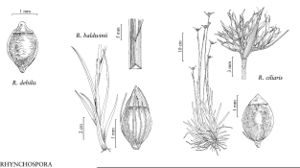Rhynchospora debilis
Rhodora 46: 194, plate 826, figs. 5A, B. 1944.
Plants perennial, cespitose, 20–45 cm; rhizomes absent. Culms erect to arching or spreading, leafy, ± filiform, ± terete, stiff to rather lax. Leaves exceeded by culm; blades linearfiliform, proximally shallowly concave, 1 mm, apex tapering, trigonous, blunt or broadly acute. Inflorescences: spikelet clusters 1–2, mostly compact, turbinate to hemispheric; leafy bracts setaceous, exceeding spikelet clusters. Spikelets dark redbrown, ovoid, 2–3 mm, apex acute; fertile scales obovate, 1.5–1.7(–2) mm, apex broadly rounded or retuse, midrib excurrent as cusp or mucro to 0.5 mm. Flowers: bristles 6 or vestigial, rarely reaching fruit midbody, antrorsely barbellate. Fruits 1–2 per spikelet,1.7–2 mm; body brown with large pale center, lenticular, broadly obovoid to ± orbicular, 1.2–1.5 × 1.4–1.6 mm; tubercle flat, triangular, concave-sided, 0.4–0.6 mm, sometimes apiculate.
Phenology: Fruiting late spring–fall.
Habitat: Sands and peats in low, open fields, bogs, seeps, low pinelands, savannas, and ditch banks
Elevation: 0–200 m
Distribution

Ala., Fla., Ga., La., Miss., N.C., S.C., Tex., Va.
Discussion
Rhynchospora debilis is very similar to R. wrightiana except it has smaller spikelet clusters and more depressed fruit tubercles. It is a common invader of cutover and bulldozed low pineland where it assumes a lowspreading habit, its many culms radiating from the common center much like spokes in a wheel.
Selected References
None.
